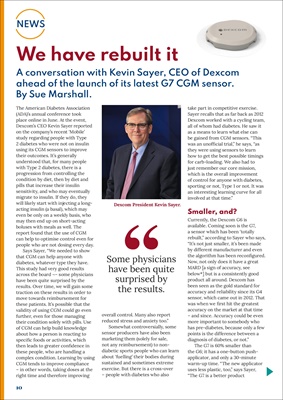
10
NEWS
We have rebuilt it
A conversation with Kevin Sayer, CEO of Dexcom
ahead of the launch of its latest G7 CGM sensor.
By Sue Marshall.
The American Diabetes Association
(ADA)'s annual conference took
place online in June. At the event,
Dexcom's CEO Kevin Sayer reported
on the company's recent 'Mobile'
study regarding people with Type
2 diabetes who were not on insulin
using its CGM sensors to improve
their outcomes. It's generally
understood that, for many people
with Type 2 diabetes, there is a
progression from controlling the
condition by diet, then by diet and
pills that increase their insulin
sensitivity, and who may eventually
migrate to insulin. If they do, they
will likely start with injecting a longacting
insulin (a basal), which may
even be only on a weekly basis, who
may then end up on short-acting
boluses with meals as well. The
report found that the use of CGM
can help to optimise control even for
people who are not dosing every day.
Says Sayer, "We needed to show
that CGM can help anyone with
diabetes, whatever type they have.
This study had very good results
across the board ¬- some physicians
have been quite surprised by the
results. Over time, we will gain some
traction on these results in order to
move towards reimbursement for
these patients. It's possible that the
validity of using CGM could go even
further, even for those managing
their condition solely with pills. Use
of CGM can help build knowledge
about how a person is reacting to
specific foods or activities, which
then leads to greater confidence in
these people, who are handling a
complex condition. Learning by using
CGM tends to improve compliance
- in other words, taking doses at the
right time and therefore improving
overall control. Many also report
reduced stress and anxiety too."
Somewhat controversially, some
sensor producers have also been
marketing them (solely for sale,
not any reimbursement) to nondiabetic
sports people who can learn
about 'fuelling' their bodies during
sustained and sometimes extreme
exercise. But there is a cross-over
- people with diabetes who also
take part in competitive exercise.
Sayer recalls that as far back as 2012
Dexcom worked with a cycling team,
all of whom had diabetes. He saw it
as a means to learn what else can
be gained from CGM sensors. "This
was an unofficial trial," he says, "as
they were using sensors to learn
how to get the best possible timings
for carb-loading. We also had to
just remember our core mission,
which is the overall improvement
of control for anyone with diabetes,
sporting or not, Type 1 or not. It was
an interesting learning curve for all
involved at that time."
Smaller, and?
Currently, the Dexcom G6 is
available. Coming soon is the G7,
a sensor which has been 'totally
rebuilt," according to Sayer who says,
"It's not just smaller, it's been made
by different manufacturer and even
the algorithm has been reconfigured.
Now, not only does it have a great
MARD [a sign of accuracy, see
below*] but is a consistently good
product all around. Dexcom has
been seen as the gold standard for
accuracy and reliability since its G4
sensor, which came out in 2012. That
was when we first hit the greatest
accuracy on the market at that time
- and since. Accuracy could be even
more important to somebody who
has pre-diabetes, because only a few
points is the difference between a
diagnosis of diabetes, or not."
The G7 is 60% smaller than
the G6; it has a one-button pushapplicator,
and only a 30-minute
warm-up time. "The new applicator
uses less plastic, too," says Sayer,
"The G7 is a better product
Dexcom President Kevin Sayer.
Some physicians
have been quite
surprised by
the results.